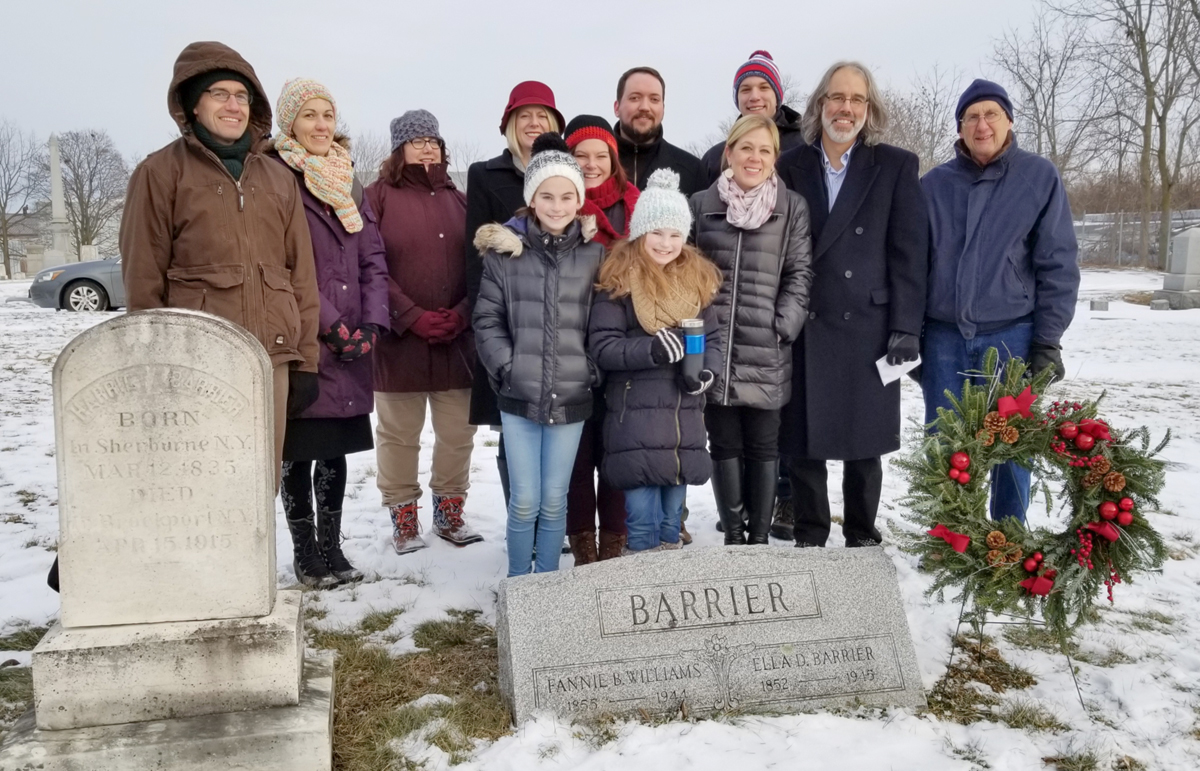Honoring Fannie Barrier Williams, Brockport’s civil rights leader

A graveside tribute at High Street Cemetery
On a cold and windy January 17, fourteen people gathered around the grave of Fannie Barrier Williams in Brockport’s High Street Cemetery to pay tribute to the life of the civil rights leader. There was a wreath-laying by Brockport Central students Sadie and Genni Contrera. The informal ceremony was organized and presided over by fourth-grade teacher Christopher Albrecht. He referred to the representatives present from The College at Brockport, the First Baptist Church (Fannie Barrier’s church), the Western Monroe Historical Society (WMHS) located in the Morgan-Manning House, and the Brockport Central Schools as “our unified way of showing our respect for this truly remarkable individual.” He recited several details of Mrs. Barrier Williams’ “amazing life.”
Ending the event, Pastor Dan Brockway of the First Baptist Church in Brockport read a summary of Mrs. Barrier Williams’ extensive accomplishments. He closed with a prayer and a biblical reading from Timothy II Chapter 4. St. Paul’s statement to Timothy included: “The time of my departure has come. I have fought the good fight; I have finished the race; I have kept the Faith.”
Student readings at the Morgan-Manning House
Continuing the Thursday afternoon graveside tribute, the program “Fannie Barrier Williams, a Woman of Courage” was presented that evening at the Morgan-Manning House in Brockport. Giving readings about her life were Christopher Albrecht, teacher at Brockport’s Hill School, and four sixth grade students. “Our presenters tonight are among the many talented students at the Brockport Central Schools,” Mr. Albrecht said as organizer of the program. “This is by choice because Mrs. Barrier Williams was a strong advocate of education.”
The students were: Isaac Allen, Sadie Contrera, Ella Johnson, and MaryGrace Kilgore, all Mr. Albrecht’s former students at Hill School. Jeffrey Xue, an eighth-grader, played piano music from the late 1800s and early 1900s, the time period of Mrs. Barrier Williams’ influence. She was a piano player as well.
The students and Mr. Albrecht followed a script giving extensive facts of Mrs. Barrier Williams’ life. With Mr. Albrecht’s occasional commentary, the students rotated their readings through the presentation: Sadie gave historic narration. Isaac read first-hand accounts of the prominent African-American males mentioned. Ella gave direct quotes from Mrs. Barrier Williams. MaryGrace injected “fun facts” about her. Jeffery played the piano at the opening and closing of the program, plus at occasional breaks in the readings.
The original script was written by Mr. Albrecht with input from the presenters, he said. “I used the research and interviews of Wanda Hendricks, Charlie Cowling, Bill Andrews and various online resources. It took me about three months to craft the script and select the best Fannie quotes to illustrate her life.”
The closing readings that evening revealed that Mrs. Barrier Williams’ husband died in 1921 in Chicago where she had worked for equal justice for over 30 years. And, other longtime associates also had passed away. “Then it was time to go home …with her beloved sister Ella — a teacher who also returned after teaching for 40 years in Washington, DC. They spent the rest of their lives in Brockport” finding it “pleasant and peaceful as it had always been.”

Fannie Barrier Williams
•A founding member of the NAACP
•Worked with W.E.B. DuBois, Booker T. Washington and Frederick Douglass
•Devoted her life to the education of freed black slaves to promote their equality
•The first black graduate of the Brockport Normal School in 1870 (which became The College at Brockport). Her sister Ella would be
the second in 1871.
•Part of the suffrage movement, the only black person to speak at the funeral of Susan B. Anthony.



